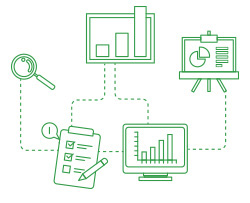The International Sustainability Standards Board (“ISSB”) officially launched its inaugural Global IFRS Sustainability Standards S1 General Requirements for Disclosure of Sustainability-related Financial Information and S2 Climate-related Disclosure on the 26th of June 2023.
As the demand for improved transparency in relation to sustainability reporting continues to grow in Australia and abroad, the IFRS Sustainability Standards (“Standards”) provides the foundations for universally applicable disclosure requirements, enabling comparable and consistent sustainability disclosures.
While numerous standards and frameworks have emerged over the years, the lack of harmonisation and comparability has hindered effective assessment and decision-making for investors and stakeholders.
Overview of IFRS 1 and IFRS 2
The launch of the Standards represents the establishment of a comprehensive global baseline of sustainability and climate-related disclosures that meets the information needs of investors to support better decision-making and “…improves trust and confidence in company disclosures…”.
In summary:
- IFRS S1 requires a company to disclose information to assess the effect of significant sustainability-related risks and opportunities they face over the short, medium, and long-term arising from dependencies and impacts on resources and relationships that an organisation maintains.
- IFRS S2 covers climate-related disclosures that are centred around the consideration of governance, strategy, and risk management of their business, and is to be used in conjunction with IFRS S1.

In the development of these Standards, the recommendations outlined in the Task Force on Climate-related Financial Disclosures (“TCFD”) have been fully incorporated.
Companies will be required to apply the Standards for annual reporting periods beginning on or after 1 January 2024. However, in the first year a company applies the Standards, the ISSB has provided a period of relief from some requirements within IFRS S1 and IFRS S2. For example, a company will be allowed to limit its disclosures in relation to information about climate-related risks and opportunities.
With the ISSB unable to mandate the application of these Standards, it will be up to jurisdictional authorities to decide whether companies will be required to comply with these Standards.
The Treasury’s Proposed Approach and Timing
Following the announcement of the Standards, the Australian Treasury published its second consultation paper outlining the key components of the Governments’ proposed climate-related financial reporting requirements as it sets to introduce standardised, internationally-aligned mandatory sustainability reporting requirements to ensure that “…large business provide Australians and investors with greater transparency and accountability when it comes to their climate-related plans, financial risks and opportunities…’’.
The Treasury will be working closely with the Australian Accounting Standards Board (“AASB”) on the development of Australia’s climate-related disclosure requirements, and this will be the focus over the next six months with the final standards up for further consultation in the second half of 2023. The proposed disclosure standards are expected to closely align to the requirements of IFRS S2.
The Treasury’s consultation paper provides information on Australia’s proposed approach towards implementation of the mandatory reporting Standards including timelines and assurance requirements.
A three-phased implementation approach has been proposed for the roll out of mandatory climate-related financial disclosures. Initially, this will start with a relatively small group of very large Australian entities, which then progressively expands over two years to apply to smaller entities. The thresholds that would determine the year in which entities are required to commence reporting are outlined below:
| Group | 1 | 2 | 3 |
| Timing | 2024-25 onwards | 2026-27 onwards | 2027-28 onwards |
| Reporting Entities | Two of the three thresholds:
AND Entities required to report under Chapter 2M of the Corporations Act that are a ‘controlling corporation’ under the NGER Act and meet the NGER publication threshold. | Two of the three thresholds:
AND Entities required to report under Chapter 2M of the Corporations Act that are a ‘controlling corporation’ under the NGER Act and meet the NGER publication threshold. | Two of the three thresholds:
AND Entities required to report under Chapter 2M of the Corporations Act that are a ‘controlling corporation’ under the NGER Act. |
What will this mean for Australian Organisations?
The launch of the Standards indicates that organisations in Australia could potentially face mandatory reporting requirements, with the redefinition of sustainability financial disclosures.
Although, it is not likely that all organisations will be required to comply with the new sustainability reporting requirements immediately, the effects of mandated reporting will eventually be felt by smaller entities. Companies should being to consider the following:
- Have you conducted a readiness assessment against the reporting requirements?
- Do you have the people, processes and systems to meet the expected reporting obligations?
- Have you identified where relevant data is located and if data gaps exist?
- Are greenhouse gas (“GHG”) emissions being measured and to what extent? Does this include Scope 1, Scope 2 and Scope 3 emissions?
- Have you identified and assessed sustainability and climate-related risks and opportunities?
- If so, have you analysed the financial impact through scenario analysis over various time horizons (i.e. 5, 10 and 15 years)?
- How is climate-related and sustainability-related risk information communicated to Executive Leadership Teams, the Board and the Audit and Risk Committee?
For more information you can also watch our Sustainability matters video ‘Why acting now is important: what does IFRS S1 and S2 mean for you?’.
We Are Here to Help
With the launch of the inaugural Standards, a new era of transparency and accountability is dawning for organisations, not just in Australia, but worldwide. We are here to support you on your ESG journey, offering tailored solutions and independent assurance to help navigate the complexities of sustainability reporting and maximise the value of your disclosures.
Learn more about our ESG services or get in touch with your nearest RSM office.









